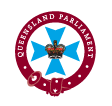-
Work of committees
- Upcoming Committee Business
- About Committees
- Training Seminar - Committees@Work
- Committees (13)
- Committees Glossary
- Estimates Hearings
-
Inquiries
- Live and Archived Broadcasts
- Publications
- Guidelines (4)
- Subscribe
- Former Committees (57)
- 30 Year Release
- Past Alert Digest and Legislation Alert Indexes
- Ten Year Anniversary
Report No. 42, 55th Parliament - Auditor-General Report 12: 2016-17 Biosecurity Queensland's management of agricultural pests and diseases
False
committee's Report
The committee's report on its consideration of the Auditor-General Report 12: 2016-17 Biosecurity Queensland's management of agricultural pests and diseases was tabled on 30 August 2017.
View: Report No. 42, 55th Parliament - Consideration of the Auditor-General's Report 12: 2016-17 Biosecurity Queensland's management of agricultural pests and diseases
View: Queensland Government's interim response to the report
Referral
The Auditor-General’s report, Biosecurity Queensland's management of agricultural pests and diseases was tabled on 9 May 2017 and referred to the committee for consideration and report. The report presents the findings of a performance audit by the Queensland Audit Office to determine whether the Department of Agriculture and Fisheries, through Biosecurity Queensland, has been achieving its agricultural pest and disease management outcomes. To assess this, the Queensland Audit Office (QAO) focused its inquiry on how efficiently and effectively Biosecurity Queensland detects, responds to, and manages significant agricultural pests and diseases.
The Auditor-General's Recommendations
The Auditor-General’s report recommended that the Department of Agriculture and Fisheries:
1. continue to develop an appropriate number of specific, measurable, achievable, relevant, and timed key performance indicators for each of Biosecurity Queensland’s key activities or initiatives (Chapter 2). In doing so, it should:
- plan how Biosecurity Queensland will collect and analyse data to monitor these key performance indicators
- collaborate with industry and other stakeholders where appropriate on the collection of data to support performance monitoring
- evaluate the success of key activities or initiatives in delivering the desired outcomes
2. improve quarterly reporting processes by not only reporting on inputs and activities for key biosecurity initiatives, but also on risks and progress towards achieving objectives and outcomes to support strategic management decisions (Chapter 2)
3. ensure that when Biosecurity Queensland participates in pest and disease management strategies which share responsibilities with other entities, it clearly determines:
- its roles and responsibilities compared to the other entities involved
- the key performance indicators that will be used to assess its contribution to the strategy
- which entity is best placed to monitor performance of the strategy and evaluate it at appropriate intervals (Chapter 2)
4. monitors and reports on the input costs over time for each of Biosecurity Queensland’s key outputs, activities, or initiatives to identify further efficiency improvements (Chapter 3)
5. considers options to implement the efficiency improvements that were identified during the planning of the Biosecurity Information Management System program and are now not within scope (Chapter 3).
The department, in its response to the report dated 27 March 2017, agreed to the five recommendations and advised of significant progress being made in their implementation.
Related Publications
| Publication Details | Type | Published Date | Tabled Date | Committee Name |
|---|
